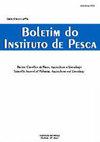EFFECT OF POULTRY LITTER AS AN ORGANIC FERTILIZER, IN WATER QUALITY, PARASITIC ABUNDANCE, AND GROWTH NILE TILAPIA
IF 0.6
4区 农林科学
Q4 FISHERIES
引用次数: 2
Abstract
Nile tilapia feed on plankton in natural environments. This food source can be increased in ponds through fertilization and can reduce feed expenses or improve fish performance when used as supplementary food. Organic fertilization is an alternative to commercial fertilization; however, its use increases concerns regarding water quality and sanitary aspects. This study aimed to evaluate the effects of the use of poultry litter as organic fertilizer on the physical and chemical parameters of water, gill ectoparasite metazoan abundance, and growth of Nile tilapia (Oreochromis niloticus) during the culture cycle lasting 240 days. Four earthen ponds, two fertilized with poultry litter and two non-fertilized ponds, as fertilized and non-fertilized treatments, respectively, were used. Stocking density was 3 fish per m2 with an average initial weight of 0.64 ± 0.15 g. The mean water quality values and the growth performance parameters of Nile tilapia did not show significant differences between the two treatments. The gill parasites found in the fish belonged to the class Monogenea, comprising two genera, Cichlidogyrus and Scutogyrus, with significant differences between treatments. The non-fertilized treatment showed a high abundance of parasites throughout the culture cycle months, with peak abundance in the months with low concentrations of dissolved oxygen in the water.禽畜粪便作为有机肥对水质、寄生丰度和尼罗罗非鱼生长的影响
尼罗罗非鱼在自然环境中以浮游生物为食。这种食物来源可以通过施肥在池塘中增加,作为补充食物可以减少饲料费用或提高鱼的生产性能。有机施肥是商业施肥的替代品;然而,它的使用增加了人们对水质和卫生方面的关注。本研究旨在评价在240 d的养殖周期内,禽畜粪便作为有机肥对尼罗罗非鱼(Oreochromis niloticus)水体理化参数、鳃外寄生虫后生动物丰度和生长的影响。4个土池,2个鸡舍施肥,2个不施肥,分别作为施肥和不施肥处理。放养密度为3尾/ m2,平均初始体重为0.64±0.15 g。尼罗罗非鱼的平均水质值和生长性能参数在两种处理间无显著差异。该鱼的鳃寄生虫属单属纲,包括两属,分别为奇鱼gyrus和Scutogyrus,处理间差异显著。未施肥处理表明,在整个培养周期的几个月里,寄生虫的丰度都很高,在水中溶解氧浓度较低的几个月里,寄生虫的丰度最高。
本文章由计算机程序翻译,如有差异,请以英文原文为准。
求助全文
约1分钟内获得全文
求助全文
来源期刊

Boletim do Instituto de Pesca
FISHERIES-ZOOLOGY
CiteScore
0.80
自引率
0.00%
发文量
24
审稿时长
>12 weeks
期刊介绍:
To publish original articles of research and short communications in the following áreas: Fisheries, Aquaculture, Zootechnology, Limnology, Oceanography, Biology and Pathology of aquatic organisms. The publication depends on the approval of the Editorial Board, based on the peer review.
 求助内容:
求助内容: 应助结果提醒方式:
应助结果提醒方式:


